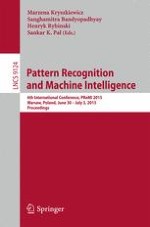2015 | Buch
Pattern Recognition and Machine Intelligence
6th International Conference, PReMI 2015, Warsaw, Poland, June 30 - July 3, 2015, Proceedings
herausgegeben von: Marzena Kryszkiewicz, Sanghamitra Bandyopadhyay, Henryk Rybinski, Sankar K. Pal
Verlag: Springer International Publishing
Buchreihe : Lecture Notes in Computer Science
